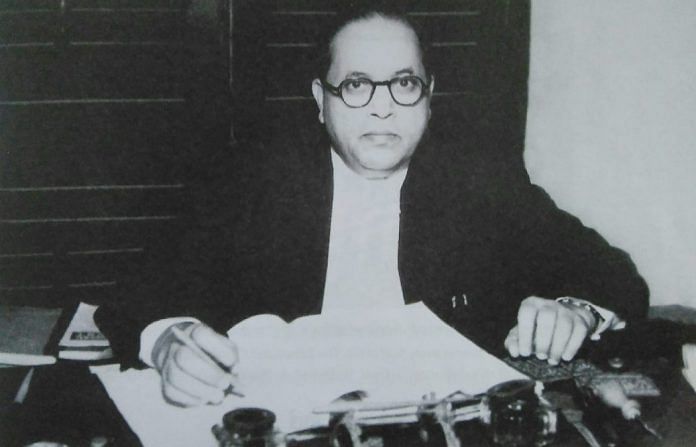
Thank you dear subscribers, we are overwhelmed with your response.
Your Turn is a unique section from ThePrint featuring points of view from its subscribers. If you are a subscriber, have a point of view, please send it to us. If not, do subscribe here: https://theprint.in/
He started the fortnightly newspaper Mooknayak. On 31 January 1920 First edition of Mooknayak was released. The date marked 100 years of Ambedkarite journalism, it was the day he launched Mooknayak in 1920, and after that he launched three more publications in Marathi – Bahishkrit Bharat, Janata and Prabuddha Bharat. He decided to launch the Mooknayak – A voice of Voiceless, because he felt that mainstream media was biased and singularly focused on freedom struggle and was neither speaking nor reporting about the atrocities happening on the dalits, no-one is becoming the voice of the millions of oppressed communities.
Ambedkar was 29 when he launched the Mooknayak in a small office in the working class neighbourhood of Parel in Mumbai.
“There is no better source than the newspaper to suggest the remedy against the injustice that is being done to our people in the present and will be done in the future, and also to discuss the ways and means for our progress in the future,” Ambedkar wrote in his first editorial in the Mooknayak.
“The fact is that concerns related to untouchables cannot have proper space in these newspapers. No one can deny and everyone would agree that to raise and discuss the pitiable situation of untouchables there is a need for an independent newspaper. To fill that gap, this newspaper (Mooknayak) has been started.” (In first copy of Mooknayak)
He wrote dozens of editorials in his paper on the practise of untouchability, and raised a demand for a caste-wise representation of people if Swaraj (self-rule) was attained.
In April 1927, he bought a printing press through donations. He named it ‘Bharat Bhushan Printing press’ and launched ‘Bahishkrit Bharat (Ostracized India)’, another fortnightly newspaper. These were the times of post-Mahad agitation for the right of drinking water from a public source.
Mahad satyagraha was a movement led by Ambedkar on 20 March 1927 to allow untouchables to use water in a public tank in Mahad (currently in Raigad district), Maharashtra.
His writings in ‘Bahishkrit Bharat’ communicated his ideas on the challenge posed by the practise of untouchability and how the ‘untouchables’ could fight it. He used the paper to raise the demand for opening temples and public water sources to Dalits.
But Bahishkrit Bharat, too, faced financial difficulties, shutting down in November 1929. In 1930, Ambedkar started another fortnightly called Janta, and later in 1954, he relaunched it as Prabuddha Bharat, a weekly in 1956, to coincide with his drive to mass conversion to Buddhism with his followers. All of its issues carried the line “Founded by Dr Ambedkar” below the masthead.
The animosity of the Congress Press towards me can to my mind not unfairly, be explained as a reflex of the hatred of the Hindus for the Untouchables,” he had said.
From 1920 to 2020, the world has changed a lot, and so has the media landscape. It has seen changes in terms of content, medium, and technology. But the quest of the Dalits to have their own media is something that still exists, maybe with more fervor now.
Caste bias in media
Newspapers and TV channels are largely run by ‘upper’ caste Hindus and they decide what will be published and what will be the tone and tenor of the content. This sociological structure of the Indian newsroom has been a subject of regular scrutiny and it has been proven, with empirical facts, that SC/STs and OBCs are almost missing in the newsrooms, especially in decision-making positions.
As the Indian media is advertisement-driven, there exists a bias to produce content that is suitable to the consumption-friendly upper strata, because it is this group that the advertisers want to have in their media plan.
With the government being the biggest advertiser in India, media houses try not to antagonise the establishment on most occasions, even if it results in publishing something that is not in the interest of the masses.
The progressive section of the media produces only a small part of the content that is available for public consumption, which mostly has pro-elite biases.
Content for the mainstream
These factors create a void in the media landscape, because it is simply not possible for media houses to cater to the needs of the subaltern. This happens because of the structure of their business. And since the ‘upper’ caste-dominated newsrooms also have an agency of their own, they can’t focus on the issues of the marginalised.
This existing matrix of structure and agency has resulted in a strong upper-caste bias in media content. This is more visible whenever there is news involving caste, like reservation, caste census or SC/ST Act.
These pieces are being published as they have been received – they have not been edited/fact-checked by ThePrint.


COMMENTS